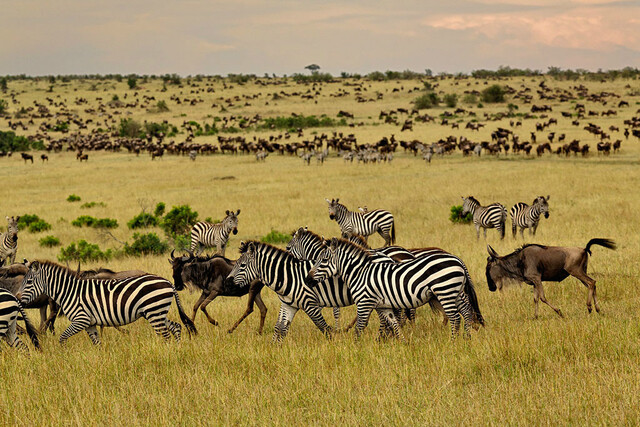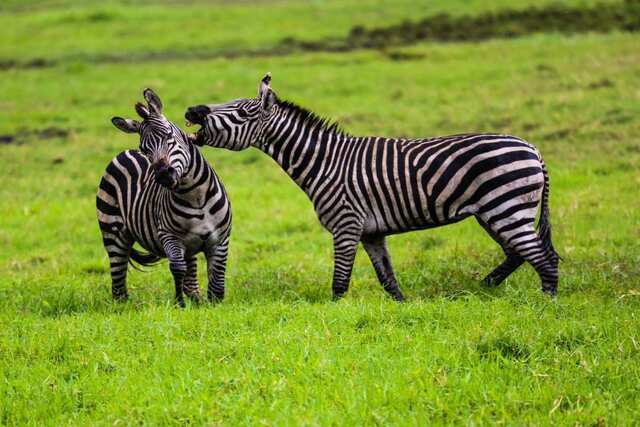Grasslands are a unique biome on Earth, known for their vast expanses of grassland, abundant sunlight, seasonal rainfall, and abundance of herbivores. Here, tall grasses not only provide food for herbivores, but also form the environment in which they live. There are many different types of grassland ecosystems around the world, such as tropical grasslands (also known as savannas) and temperate grasslands, which together support rich biodiversity.
This article will explore the tall grasses and herbivores in grassland ecosystems, and understand their lifestyles and interdependence in this environment.
Grasslands are vast ecosystems dominated by grass plants, and grasslands cover about 25% of the world's land area. According to geographical location and climatic conditions, grasslands are divided into the following categories:
Tropical grasslands: also known as savannas, they are mainly distributed in Africa, South America and Australia, with relatively warm climates and moderate precipitation.
Temperate grasslands: such as the Great Plains of North America, the grasslands of Ukraine, and the Pampas of Argentina, these grasslands have a relatively dry climate and large temperature changes.
The main characteristics of grassland ecosystems include: large areas of grassland, sparse trees, strong seasonal precipitation, and abundant herbivorous animal populations.

Grassland grasses are known for their height and diversity. Tallgrasses are particularly important because they provide abundant food resources for herbivores and protect animals from predators. Grasses play several key roles in grassland ecosystems:
Food provision: Herbivores feed mainly on grasses, and the leaves and seeds of tall grasses provide them with sufficient nutrition.
Habitat: Tall grasses not only provide shelter for animals, but also help them avoid predators and extreme climatic conditions.
Ecological balance: Grasses form a symbiotic relationship with microorganisms in the soil, helping to maintain the health of the grassland and the fertility of the soil.
Common tall grasses include: Stipa gigantea, Andropogon gerardii, Schizachyrium scoparium, etc.
Grasslands are home to a large number of herbivores that rely on tall grasses and other grassy plants for food. The following are some common herbivores in grassland ecosystems:
Distribution: African grasslands and savannas
Characteristics: Elephants are the world's largest terrestrial herbivores, feeding on grasses, leaves, bark, and fruits. The long trunks and large size of Elephants-Are-Endangered.html">elephants enable them to consume large amounts of vegetation, which has a significant impact on grassland plant communities.
Distribution: African savannah
Characteristics: Giraffes are the tallest animals in the world. They mainly feed on the leaves of tall trees in the savannah, but they also eat grass. The giraffe's long neck allows them to eat food sources that other animals cannot reach.
Distribution: Grasslands of Africa, Asia and North America
Characteristics: There are many types of antelopes, such as gazelles, wildebeests, and blackbucks. They are all typical herbivores that eat grass, shrubs, and other low vegetation. Antelopes usually migrate in groups to find abundant grass.
Distribution: North American grasslands
Characteristics: Bison were once widely distributed on the Great Plains of North America. They are large herbivores that feed mainly on tall grasses. Bison herds migrate across the grasslands, eating as they move, helping to promote the regeneration of grassland plants.
Distribution: African grasslands
Characteristics: Zebras feed mainly on grass, especially tall grass in long grass grasslands. They are known for their unique black and white stripes, which help them hide on the grassland and prevent attacks from predators.
Distribution: Australian grasslands
Characteristics: Kangaroos are the most representative herbivores on the Australian grasslands. They mainly feed on grass, leaves and shrubs. Kangaroos' jumping ability enables them to move quickly and avoid predators.
Distribution: Temperate grasslands of North America and Northern Europe
Characteristics: Moose are large herbivores living in temperate grasslands. They feed on grasses and shrubs, and have strong survival abilities, especially in cold regions.

Herbivores on the grassland are not only closely related to grass plants, but also face the threat of predators. Carnivores such as lions, cheetahs, and wolves rely on these herbivores for food, forming a predation chain in the grassland ecosystem. The existence of predators maintains the balance of herbivore populations to a certain extent, avoiding overgrazing and causing imbalance in the ecosystem.
In addition, some herbivores, such as antelopes and zebras, form cooperative defense mechanisms and act collectively to reduce the probability of being preyed upon.
Grasslands not only provide habitats for a large number of animals, but also have important significance for global ecosystems. They have the following functions:
Carbon storage: Plants on grasslands can store large amounts of carbon, which helps mitigate climate change.
Soil protection: The roots of grass plants help prevent soil erosion and maintain the fertility of the land.
Biodiversity: Grassland ecosystems have rich plant and animal diversity, supporting the survival and reproduction of many species.
Grassland ecosystem is one of the most important biomes in the world. Tall grass and herbivores together constitute the core ecological relationship of grassland. Herbivores such as Elephants-Are-Endangered.html">elephants, antelopes, and zebras maintain the dynamic balance of grassland by eating grass plants. At the same time, grassland also provides a rich source of food for predators, forming a complete ecological chain. In the efforts to protect the global ecosystem, the protection of grassland is particularly important.
animal tags: Giraffe Moose Kangaroo Zebra Elephant
We created this article in conjunction with AI technology, then made sure it was fact-checked and edited by a Animals Top editor.